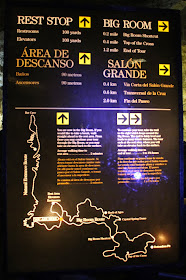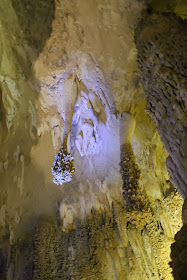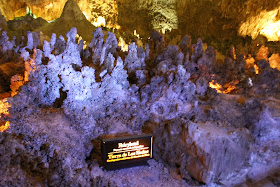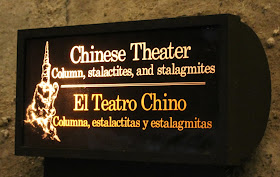One of our favorite adventures as we moved from NC to CA was exploring the Carlsbad Caverns National Park in Carlsbad, New Mexico. It was incredible getting to explore this natural wonder as a family.

Hotch and Braxton spotted these baby birds snuggled up in their nest next the boy's restroom. They were such vocal, hungry babies.


Carlsbad Caverns National Park was established in 1930 and it is an amazing experience for the whole family. We had a blast! Before descending 750 feet underground to investigate Carlsbad Caverns we made sure to pick up Junior Ranger book. (Here are the Junior Ranger Books: 6 and under & 7-12.) There are two different entrances into Carlsbad Caverns: an elevator and the natural entrance. We chose to take the elevator down and to go on the Big Room Route self-guided tour. If Hotch and I were in better shape we would have chosen the Natural Entrance Route self-guided tour since it is descends down into Carlsbad Caverns through the historic natural cave entrance. There are also many ranger-guided tours to choose from.
When we got down into Carlsbad Caverns we bought the kids some really cool head lanterns. These head lanterns were serious business and they looked awesome in them! The little ones kept blinding us with their lanterns whenever we spoke to them. It was hilarious watching them completely oblivious to the fact that they were shining the light in people's eyes.







Carlsbad Caverns National Park has more than 119 limestone caves, but the most famous cave is Carlsbad Caverns. It was formed when naturally occurring sulfuric acid seeped into the cracks of the limestone rock and created endless mazes underground. Then water drops soaked through the cracks in the limestone along with gasses and minerals it collected from the soil above. These water drops have created beautiful cave formations which are properly called speleothems. Carlsbad Caverns showcases many different speleothems. (Here is a PDF explaining cave geology.)


The Big Room Route is 1.2 miles long and took us about 2 hours to complete. We took our time stopping regularly to take photos and to really examine the cave formations. It was an incredible journey deep in the earth!



The Big Room is the largest known natural limestone chamber in the Western Hemisphere. In 1989 the estimated size was around 357,480 square feet which is about 6.2 football fields. The photos below do not do justice to the enormity of this cave chamber and the beauty that is within.




I love all of the smaller cave chambers with their own hidden treasures.


Behind Alyssa are some impressive cave formations called flowstone and coralloids. Flowstone is formed when water flows down walls or along the cave floor. Love how it looks like frozen waterfalls. Coralloids (cave popcorn) are small nodes of mineral deposits from splashing water distributed in the direction of airflow.


We viewed so many different types of cave formations.
Wish my photos did the Big Room justice.

I am in awe of the slowly forming dripstone columns. Columns are formed when a stalactite (hanging from ceiling) and stalagmite (rising from floor) meet.




Not everyone was as in awe with this nearly developed column as I was. Brax and Lane look a bit bored, but they were actually annoyed I made them stop exploring to take a photo. They had to stop having fun to appease mom.


The lighting inside Carlsbad Caverns is really lovely in parts of the cave. I love this photo, but I wish my camera could capture all the details.

Lion's Tail is a stalactite with coralloids (cave popcorn) covering its end.
The kids thought it was a pretty cool, well-named stalacite.


The Hall of Giants contains the three largest speleothems in the cave. On the right is Giant Dome, a column, which stands 62 feet above the walking trail. Long ago Giant Dome was a slowly forming stalagmite. It became a column once it touched the ceiling of the cave. On the left are Twin Domes, two stalagmites, which both stand about 58 feet above the walking trail. One day they will also touch the ceiling and become columns.




In Fairyland there are many newer, much smaller stalagmites.

The Temple of the Sun is a large flowstone covered column. It is gorgeous!

Breast of Venus is a beautifully forming stalagmite. Rapidly dripping water created the wide base and now slow dripping water is creating the narrow tip.

Love the look of these stalactites. The lighting was impeccable!


Crystal Spring Dome, a massive flowstone-covered stalagmite, is believed to be the largest wet speleothem still growing inside Carlsbad Caverns. About 95% of the speleothems are now dry and will no longer continue to grow. There is also a drip pool surrounding Crystal Spring Dome's base.




Look at how delicate and beautiful these cave formations are!



Rock of Ages is a large flowstone-covered column.

Draperies are beautiful, thin speleothems that form when water flows over steep inclines. They can be so thin that they are translucent.



I love the quiet beauty of the cavern pools! A unique type of speleothem called shelfstone is forming around the cavern pools pictured below. Shelfstone forms at or just below the waterline in cave pools if the water level stays the same for a long period of time. The water is so clear.



The Painted Grotto has hundreds of delicate stalactites called soda straws. Over time minerals other than calcite in water drops have stained these hollow stalactites with various hues of yellow, orange, red and brown.



The Doll Theater has many soda straws and small columns.

Wonder where this part of the cave leads to.

It seemed like there were more cavern pools the closer we moved to the cave elevators. I love the cavern pools! They are amazing.


Carlsbad Caverns' Chinese Theater totally reminded me of the Chinese Theater in Hollywood, CA.




By the time we reached the end of the Big Room Route we were tired, but we all had a blast. It was seriously worth the time we spent there. We all want to return here again and continue exploring Carlsbad Caverns.



These photos totally crack me up! We are an odd bunch!




Braxton and Delaney earned their Junior Ranger bandages. They were totally stoked! I love that they still have their headlamps on.

The cave maintains a cool 56 degrees year-round which felt really nice compared to the sunny warm 85 degree weather outside.

We loved exploring Carlsbad Caverns National Park and we totally recommend it for the whole family! It was a wonderful, educational experience too. Here is a great PDF with information on Cave Geology and here is a PDF with the Caverns' Chronology.

We left Carlsbad Caverns National Park looking forward to our next adventure of the day: Guadalupe Mountains National Park.


No comments:
Post a Comment